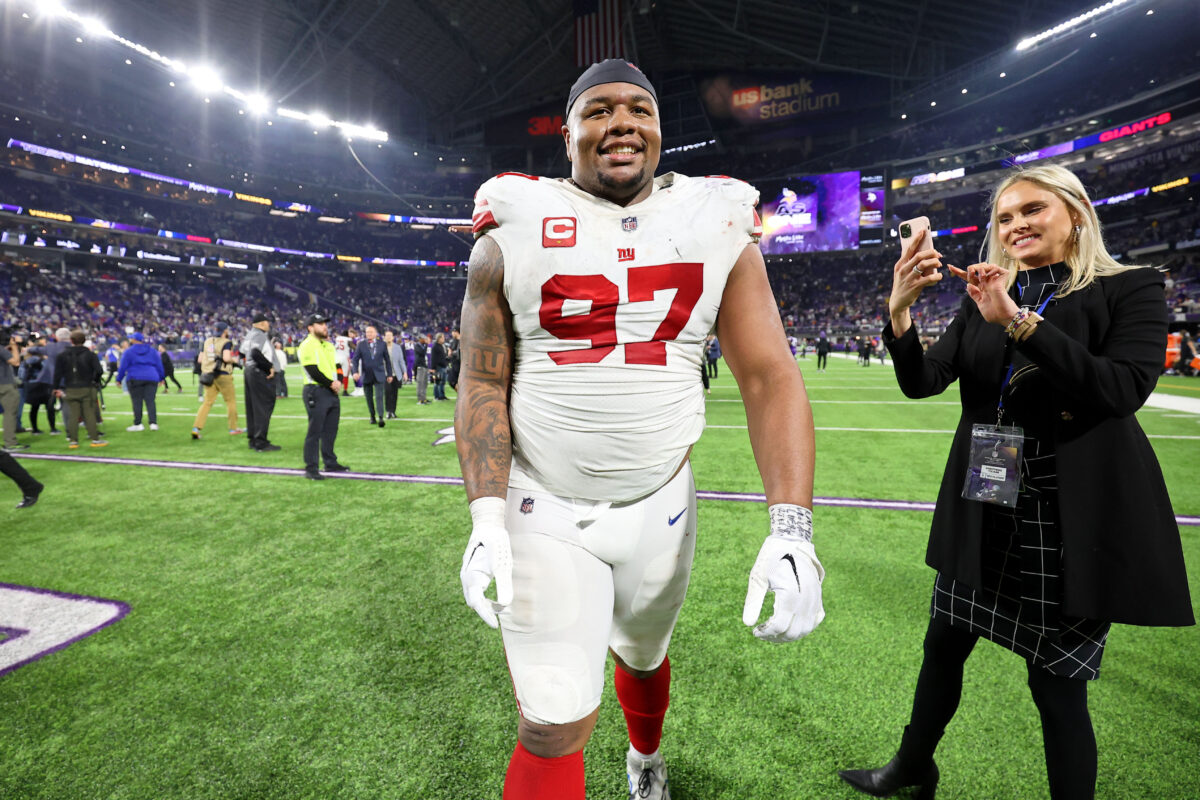New York Giants defensive coordinator Don “Wink” Martindale is fond of saying that if you are wearing a Giants helmet, you are going to attack on defense. That’s always been Wink’s modus operandi — when he was the Baltimore Ravens’ defensive coordinator from 2018 through 2021, Baltimore regularly led the NFL in blitz rate. That has transferred to the Giants in Martindale’s first year on the job. In 2021, Bug Blue blitzed exactly 25% of the time. This season? No team has blitzed at a higher rate than the Giants’ 39.7%, and it isn’t close — in the regular season, the Arizona Cardinals ranked second in blitz rate at 34.5%.
So, you know what you’re going to get when facing a Wink Martindale defense from that perspective. And generally, he’ll throw in a high rate of man coverage to go along with all those blitzes. That was what the Giants did through Week 14, which marked their first of two regular-season games against the Philadelphia Eagles, who they’ll face in Saturday night’s divisional round contest.
Through Week 14, per Sports Info Solutions, only the New Orleans Saints and the Pittsburgh Steelers had more opponent passing attempts in man coverage than the Giants’ 176. And on those 176 attempts, Martindale’s defense allowed 124 completions for 1,129 yards, seven touchdowns, two interceptions, and an opponent passer rating of 79.0. Only the Steelers blitzed on more opponent passing attempts with man coverage than the Giants’ 84 — Martindale’s squad gave up 44 completions for 498 yards, two touchdowns, one interception, and an opponent passer rating of 73.4.
But since that first Eagles game, Martindale has changed his coverage concepts pretty drastically. The Giants are still attacking with blitzes, but they’re playing much more zone coverage — especially split-safety zone. Perhaps it was what happened in that 44-28 loss to the Eagles that changed Martindale’s mindset. In that game, Jalen Hurts set New York’s man coverage to “Julienne” in the Cuisinart, completing nine of 16 passes for 152 yards, two touchdowns, no interceptions, and a passer rating of 128.1. Against man coverage and the blitz, Hurts completed six of 10 passes for 99 yards, one of his touchdowns, and a passer rating of 126.7.
From Week 15 through the team’s wild-card win over the Minnesota Vikings, the Giants have faced 100 passing attempts in zone coverage, seventh-most in the league. They’ve allowed 69 completions for 788 yards, one touchdown, one interception, and an opponent passer rating of 91.8. They’ve blitzed with zone coverage on 29 opponent passing attempts since Week 15 — only the Tampa Bay Buccaneers did it more often in that time — allowing 21 completions for 347 yards, no touchdowns, no interceptions, and an opponent passer rating of 112.3, which ranks third-worst in the league.
So, it looks on the surface that Martindale’s switch from man to zone has made his defense more vulnerable. But if Eagles quarterback Jalen Hurts has one bit of Kryptonite in what has been an MVP-level season, it’s the ability to deal with blitzes and zone coverage behind them. Hurts has faced zone coverage with blitzes on 51 of his dropbacks this season, and he’s completed just 23 passes for 274 yards, no touchdowns, no interceptions, and a passer rating of 78.5 — seventh-worst in the NFL.
“Everybody’s saying he’s having an MVP season, and I agree because he can beat you with his legs,” Martindale said this week of Hurts. “He can beat you with just being a dropback quarterback. He can beat you with a sore shoulder. He can beat you a lot of different ways, and that’s a great challenge because there’s just a few quarterbacks that can do it that way. And you can have him dead to rights back there n the pocket, and he’s a magician. He’ll get out of it.
“I’m not happy for the guy right now because I’m preparing for him. But you can see the work that he put in the past offseason. And where he’s at today is, to me, two completely different quarterbacks. Out of respect of the game, you respect that. You can see the hard work that he put in. It’s going to be a tremendous challenge.”
Perhaps one way to mitigate that challenge in the Giants’ favor is for Martindale to show Hurts things he hasn’t really seen from his defense.


